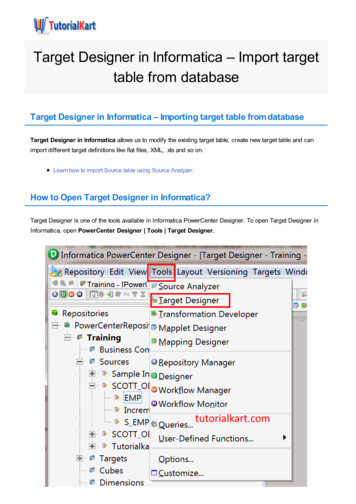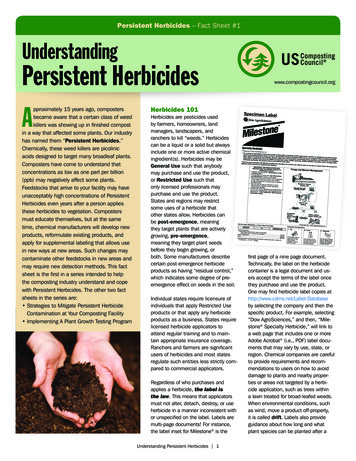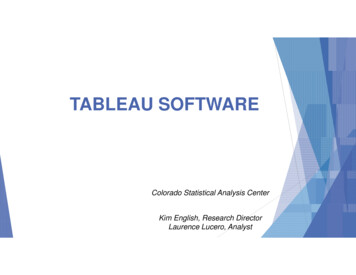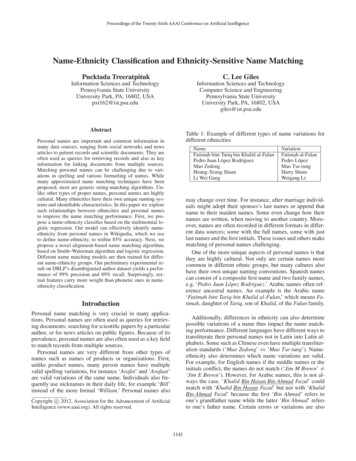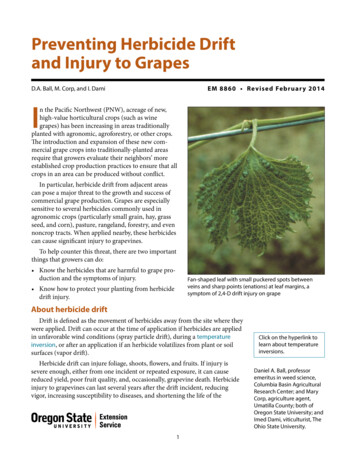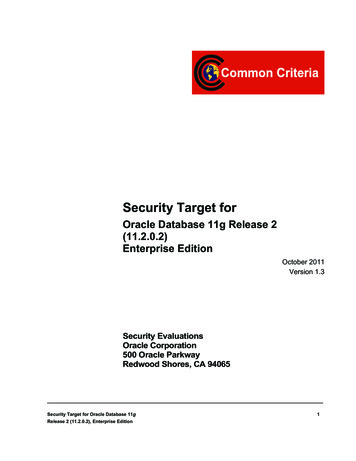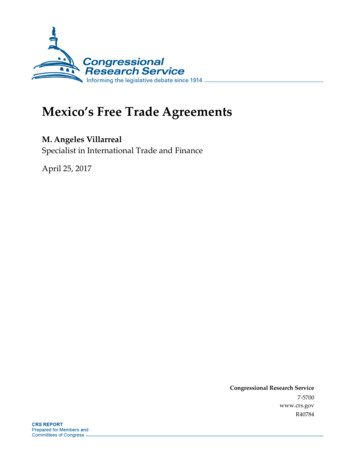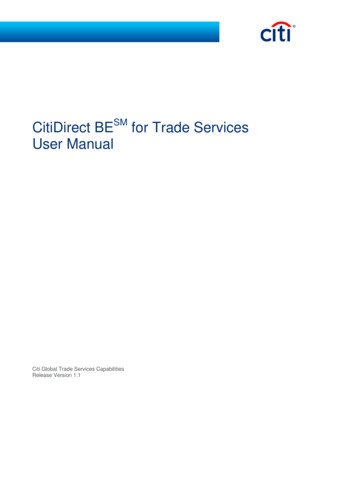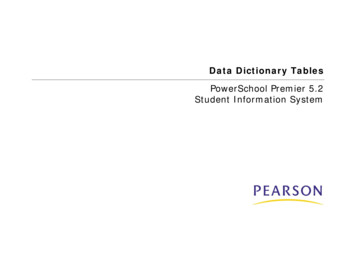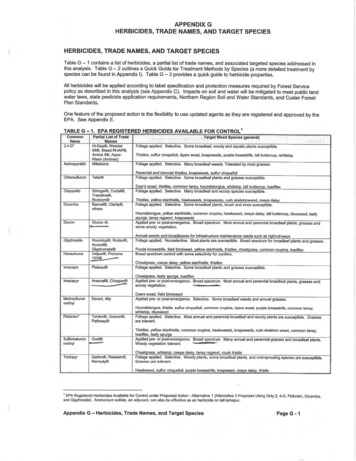
Transcription
APPENDIXGHERBICIDES, TRADE NAMES, AND TARGET SPECIESHERBICIDES, TRADE NAMES, AND TARGET SPECIESTable G - 1 contains a list of herbicides, a partial list of trade names, and associated targeted species addressed inthis analysis. Table G - 2 outlines a Quick Guide for Treatment Methods by Species (a more detailed treatment byspecies can be found in Appendix I). Table G - 3 provides a quick guide to herbicide properties.All herbicides will be applied according to label specification and protection measures required by Forest Servicepolicy as described in this analysis (see A ppendix C). Impacts on soil and water will be mitigated to meet public landwater laws, state pesticide application requirements, Northern Region Soil and Water Standards, and Custer ForestPlan Standards.One feature of the proposed action is the flexibility to use updated agents as they are registered and approved by theEPA. See Appendix E.TABLE G -1CommonName2,4-D'EPA REGISTERED HERBICIDES AVAILABLE FOR CONTROL 1AminopyralidPartial List of TradeNamesHi-Dep , Weedar64 , Weed RHAP ,Amine 4 , AquaKleen (Amines)MilestoneChlorsulfuronTela' ClopyralldStringer , Curtail ,Transline ,Redeem Banvel , Clarity ,othersDicambaDiuronGlyphosateHexazinoneDiuron 4L;-Roundup , Rodeo ,Accord ,Glvohomate Velpar , Pronone lmazapiclmazapyrMethsulfuronmethylPicloram SullometuronmethylTriclopyrPlat eau ---Arsenal , Chopper Target Weed Species (general)Foliage applied. Selective. Some broadleaf, woody and aquatic plants susceptible.ThisUes, sulfur cinquefoil, dyers woad, knapweeds, purple loosestrife, tall buttercup, whitetopFoliage applied. Selective. Many broadleaf weeds. Tolerated by most grasses.Perennial and biennial thistles, knapweeds, sulfur cinquefoilFoliage applied. Select ive. Some broadleaf plants and grasses susceptible.Over's woad, thistles, common tansv, houndstonaue whitetoo, tall buttercuo, toadflaxFoliage applied. Selective. Many broadleaf and woody species susceptible.Thistles, vellow starthistle, hawkweeds, knaoweeds, rush skeletonweed, oxeye daisyFoliage applied. Selective. Some broadleaf plants, brush and vines susceptible.Houndstongue, yellow starthistle, common crupina, hawkweed, oxeye daisy, tall buttercup, blueweed, leafyspurAe, tansv ranwort, knaoweedsApplied pre- or post-emergence. Broad spectrum. Most annual and perennial broadleaf plants, grasses andsome woody vegetation.Annual weeds and broadleaves for infrastructure maintenance needs such as right-of-waysFoliage applied. Nonselective. Most plants are susceptible. Broad spectrum for broadleaf plants and grasses.Purole loosestrife, field bindweed, vellow starthistle, thistles, cheatorass, common cruoina, toadflaxBroad spectrum control with some selectivity for conifers.Cheatarass, oxeve daisv, vellow starthisUe, thistlesFoliage applied. Selective. Some broadleaf plants and grasses susceptible.Cheatorass, leafv sourae, toadflaxApplied pre- or post-emergence. Broad spectrum. Most annual and perennial broadleaf plants, grasses andwoody vegetation.Escort, AllyOvers woad, field bindweedApplied pre- or post-emergence. Selective. Some broadleaf weeds and annual grasses.Tordon , Grazon ,Pathway Houndstongue, thistle, sulfur cinquefoil, common crupina, dyers woed, purple looaestrife, common tansy,whitetoo, blueweedFoliage applied. Selective. Most annual and perennial broadleaf and woody plants are susceptible. Grassesare tolerant.Oust .-Garton , Redeem ,Remedy Thistles, yellow starthistle, common crupina, hawkweeds, knapweeds, rush skeleton weed, common tansy,toadflax, leafv souroeApplied pre- or post-emergence. Broad spectrum. Many annual and perennial grasses and broadleaf plants.Woody vegetation tolerant.Cheatarass, whitet oo, oxeve daisv, tansv raawort, musk thistleFoliage applied. Selective. Woody plants, some broadleaf plants, and root-sprouting species are susceptible.Grasses are tolerant.Hawkweed, sulfur cinauefoil, ourole loosestrife, knaowee d, oxeve daisv, thistle' EPA Registered Herbicides Available for Control under Proposed Action - Alternative 1 (Alternative 3 Proposes Using Only 2, 4-D, Picloram, Dicamba,and Glyphosate). Ammonium sulfate, an adjuvant, can also be effective as an herbicide on tall larkspur.Appendix G - Herbicides, Trade Names, and Target SpeciesPage G - 1
APPENDIXGHERBICIDES, TRADE NAMES, AND TARGET SPECIESTABLE G- 3. QUICK GUIDE TO HERBICIDE PROPERTIESProductNameArsenalBanvelConfrontActive lngredlent(s)imazapyrdicambaclopyralid: triclopyrCautionWaminaDangerCrossbowtriclopyr: 2.4-DCautionHuman Health FindingsCancer Repro·Evidence of non-carcinoqenicityNot Classifiable as a CarcinoaenNot Likely to be carcinogenic (clopyralid} Notclassified as a carcinoaen (triclopyr)Not Classifiable as a CarcinogenDirex 4LEnvv2,4-DEscortdiuron2,4-DMetsulfuron methylCautionDanoerCautionKnown/LikelyNot Classifiable as a CarcinoaenNot Likely to be carcinogenicGarlon 3AGarlon4KarmexLontrelLowVol 4DMilestoneOustPathfinder IIPlateauRodeoRoundup[18% cone)RoundupProScotts 30-55 wConfrontTelarToositeTordon 22KTranslineVanquishVeloarWeedar64Triclopyr famine)Tricloovr (ester}diuronc lopyralid2,4-Daminoovralidsulfometuron onCautionCautionNot classified as a carcinooenNot classified as a carcinoaenKnown/LikelyNot Likely to be carcinoaenicNot Classifiable as a CarcinogenNot Likely to be carcinooenicEvidence of non-carcinoqenicityNot classified as a carcinooenEvidence of non-carcinoaenicitvEvidence of non-carcinooenicityEvidence of non-carcinogenicityglyphosateCautiontriclopyr; clopyralidWarningChlorsulfuron 75%imazaovr: ted"RestrictedSignalNeuro ··EndoProbPersist-enceModLowModMobllltyV HiQhLowModV HiahLow-ModLowModHiohModModModLowHiqhE LowE LowEvidence of non-carcinogenicityModELowNot Likely to be carcinogenic (clopyralid) Notclassified as a carcinoqen (triclopyr)Evidence of non-carcinoaenicitvKnown/Likelv (diuronlEvidence of non-carcinoaenicitvNot Likelv to be carcinooenicNot Classifiable as a CarcinoQenNot Classifiable as a CarcinoaenNot Classifiable as a CarcinoaenModV HighModModModModLowModLowHiahHiahV HiQhV HiqhV HiqhVHiahModProbProbFishBeeWIid- lifeHighVHiohVHighLow,ModModLowLow ghToxicToxic' Restricted. A Restricted Use Pesticide is a pesticide that is available for purchase and use only by certified pesticide applicators or persons under their direct supervision. This designation is assigned to a pesticide productbecause of its relatively high degree of potential human and/or environmental hazard even when used according to label directions.7Signal Word. The herbicide label indicates the extent of toxicity by the signal word(s) it carries. The signal word on the label applies to the most serious method or route of exposure. For example, if a herbicide has anacute oral LOSO of 368 (which triggers the signal word "Warning") and an acute dermal LOSO of 2,000 (which triggers "Caution") and is severely and irreversibly corrosive to the eyes (which warrants "Danger"}, then thelabel signal word is "Danger."8The EPA evaluates carcinogenicity (cancer}, neurotoxicity, reproductive, teratology (birth defects}, and mutagenicity (gene mutation) study results of herbicide effects to animals during the herbicide registration and re registration processes. The shJdy data is used to make inferences relative to human health.Cancer column. When assessing possible cancer risk posed by a pesticide, EPA considers how strongly carcinogenic the chemical is (its potency) and the potential for human exposure. The pesticides are evaluated notonly to determine if they cause cancer in laboratory animals, but also as to their potential to cause human cancer. For any pesticide classified as a potential carcinogen, the risk would depend on the extent to which a personmight be exposed (how much time and to what quantity of the pesticide). The factors considered include short-term studies, long-terrn cancer studies, mutagenicity studies, and structure activity concerns. (The term "weight of-the-evidence" is used in referring to such a review. This means that the recommendation is not based on the results of one study, but on the results of all studies that are available.). Diuron is a likely or known carcinogen.However, the EPA's 2002 re-registration assessment of the human and environmental scientific data reinforces a number of regulatory decisions and expert reviews that conclude the use of diuron according to productinstructions does not present an unacceptable risk to human health or the environment.9Reproductive column. EPA Registration/ re-registration studies for the herbicides addressed in this analysis did not indicate any reproductive issues.10Neurotoxicity column. EPA Registration/ re-registration studies for the herbicides addressed in this analysis did not indicate any neurotoxicity issues.11Endocrine disruption column. EPA Registration/ re-registration studies for the herbicides addressed in this analysis did not indicate any reproductive issues except for probable issues for 2 , 4-D. Based on currentlyavailable toxicity data, which demonstrate effects on the thyrcid and gonads in test animals following exposure to 2, 4-D, there is concern regarding its endocrine disruption potential. There have been no studies on 2, 4-Dthat specifically assess its endocrine disruption potential. The EPA determined that a rep eat 2-generation reproduction study is required to address these concerns. However, the EPA's 2005 re-registration assessment ofthe human and environmental scientific data reinforces a number of regulatory decisions and expert reviews that conclude the use of 2, 4-D according to product Instructions does not present an unacceptable risk to humanhealth or the environment.Appendix G - Herbicides, Trade Names, and Target SpeciesPage G-3
The Low-Impact List from Oregon State University Do not apply pesticides to classrooms, athletic fields, or any other space while it is being used.Store all pesticides in a cool, dry place with limited access.Store liquids below granules and dusts, just in case the liquid container leaks.At the very least, wear long pants, long sleeves, shoes and socks when handling or using any pesticide product.Keep people and pets off treated areas until sprays or wetted granules have dried.Do not apply products in a way that will contact people, either directly or through drift.Attend a training event for School lPM Coordinators presented by the OSU School 1PM Program,and check out the templates , training tools , and model 1PM plans here. WARNING:"Non-crop areas" include uncultivated agriculture, farmyards, fuel storage areas, fence rows, rights-of-way, and fallow land.That term does NOT include ornamental sites, turf, or sports fields.Oregon lawi requires pesticide applicators to use only low-impact pesticide products in and around schools. The law defines "low impact" in specific terms.ii School districts may evaluate products according to the law and maintain their own list(s) of low-impactpesticide products. Oregon State University (OSU) has evaluated products upon request and created this list, which governingbodies are welcome to use in lieu of, or in addition to, their own low-impact lists. The list is a guide and not intended as arecommendation or endorsement of the pesticides listed within. Consult with your supplier, pest management professional, orOregon Department of Agriculture prior to pesticide use. Always read the label and follow all directions before you apply anypesticides. The Label is the Law!To request new products for the list, to be evaluated by Kaci Buhl at Oregon State University, submit your request using this form.Thanks for everything you do to protect people and property from pests and unnecessary pesticides. You are the coolest!,l k A-h:'.0--
Ornamental & turf sites are NOT included in the definition of "non-crop areas."September 15, 2017The products listed here meet the criteria under the law for use in and around Oregon schools and they are registered for sale inthe state of Oregon. iii Use the EPA Registration number to match products on the list. The same product name can be usedfor different products, so matching the product name(s) below to products on the shelf is not sufficient. This table issorted by EPA Registration number (lowest to highest).HerbicidesProduct NameEPA Reg. No.Tenacity100-1267Refuge100-1 362Cornerstone Plus Agrisolutions1381-192Drexel Simazine 4LIi-19713-60Activelngredient(s)Read the label, use products only for labeled uses, andbe aware of the following:mesotrioneThis product is harmful if absorbed through skin . Prolonged or repeatedskin exposure may cause allergic reactions. Avoid contact with skin,eyes, or clothing. All handlers must wear chemical-resistant gloves. Donot contaminate water. This product has a high potential for runoff forseveral weeks after application. Avoid application when rain is expectedwithin 48 hours. Certain insecticides, when applied within 7 days ofTenacity, can cause turf iniurv.IglyphosateIn agricultural settings, this product requires a restricted-entry interval of12 hours and chemical resistant gloves in Category A. ConsiderDt o--i)-fJ applying that same standard in your school setting. Do not mix, store, reJ./or apply this product in galvanized steel or unlined steel (exceptstainless steel) containers.glyphosateThis product causes moderate eye irritation. Do not mix, store, or applyisopropylami11e sa i.--this product in galvanized steel or unlined steel containers; it may form i "Ste, .a highly combustible gas mixture. Be sure to follow the directions for('OJ,.c) J fnon-crop areas.simazineThis product is labeled for use on ornamental lawns . There are no otherschool sites listed (i.e. athletic fields). This product causes moderater \Peye irritation, and it can be harmful if absorbed through the skin . Avoido.,. Sc,le.f./contact with eyes, skin or clothing. All handlers must wear chemicalIOresistant gloves. Do not apply this product to sandy soils where thewater table is close to the surface. This product is toxic to aquaticorganisms. Do not mix this product within 50 feet of water bodies orwells. When used in agriculture, this product requires a re-entry intervalof 12 hours. Consider applying that same standard in your schoolsetting. Do not use on alkaline soils (pH above 7.8). Do not apply overthe rootinq zone of trees or ornamentals that are not listed on the label.-2
Ornamental & turf sites are NOT included in the definition of "non-crop areas."Simazine1971 3-252simazineµ!f;f!/,(JC/Drexel De-ester L V619713-6552,4-D, ethylhexylesterGordon's AgriculturalProducts BrushmasterHerbicide2217-7742,4-D ethylhexylester, 2,4-DP,dicambaGordon's ProformProfessionalFormulations SpeedZone BroadleafHerbicide for Turf2217-8332,4-D ethylhexylester, mecoprop-p,dicamba,carfentrazone ethylSeptember 15, 2017This product is labeled for use on lawns. There are no other schoolsites listed (i.e. athletic fields). This product causes moderate eyeirritation, and it can be harmful if absorbed through the skin. Avoidcontact with eyes, skin or clothing. All handlers must wear chemicalresistant gloves. Do not apply this product to sandy soils where thewater table is close to the surface. This product is toxic to aquaticorganisms. Do not mix this product within 50 feet of water bodies orwell s. When used in agriculture, this product requires a re-entry intervalof 12 hours. Consider applying that same standard in your schoolsetting. Do not use on alkaline soils (pH above 7.8). Do not apply overthe rooting zone of trees or ornamentals that are not listed on the label.This product is moderately toxic to the eyes. Avoid contact with skin,eyes, or clothing. Prolonged or frequent repeated skin contact maycause allergic reactions. This product may be toxic to aquatic life, and ithas properties associated with groundwater contamination. Applicationaround a cistern or well may result in drinking water contamination. Onornamental turf, only two aoolications oer vear are allowed.The only school sites on the label (under "Recommended Noncroplandsites") are roadsides, fencerows, fence-lines, and areas adjacent toathletic fields. Avoid contact with eyes, skin or clothing, or inhalingspray mist. This product is harmful if absorbed through the skin orinhaled. Over time, it may cause allergic reactions in individuals whoare repeatedly exposed. Applicators must wear chemical-resistantgloves. A chemical resistant apron is needed when working with theconcentrate. Application to sandy soils, particularly where the watertable is shallow, could result in groundwater contamination. Do notapply this product to shorelines, wetlands, or ditch-banks. Do not applythis product where drift may occur to ornamentals, fruit trees,vegetables, and other susceptible broadleaf plants. Do not apply whenhumidity is low and temperatures are high because this product mayturn to vapor and move, damaqinq desirable plants.Avoid contact with skin, eyes, or clothing. All handlers, includingmixer/loaders must wear chemical resistant gloves. A chemicalresistant apron is needed when working with the concentrate. Thisproduct causes moderate eye irritation. Prolonged or frequentlyrepeated skin contact may cause allergic reactions. Application tosandy soils, particularly where the water table is shallow, could result ingroundwater contamination. Do not apply to wetlands or shorelines.3
Ornamental & turf sites are NOT included in the definition of "non-crop areas."Gordon's ProformProfessionalFormulations SpeedZone2217-8352,4-D ethylhexylester, mecoprop-p,dicamba,carfentrazone-ehtylThe AndersonsProfessional TurfProducts Fertilizer withSurge 16-0-92217-882-91982,4-D ethylhexylesterGordon's Pro FormProfessionalFormulations T ZoneBroadleaf Herbicide2217-920dicamba, 2,4-D (2ethylhexyl ester),sulfentrazone, andtriclopyr,butoxyethyl esterGordon's ProFormProfessionalFormulations Q4 PlusTurf Herbicide forGrassy & BroadleafWeeds2217-930quinclorac, 2,4-D,dicamba,sulfentrazoneT Zone SE2217-976triclopyrbutoxyethyl ester,sulfentrazone, 2,4DSeptember 15, 2017Avoid contact with skin , eyes , or clothing. All handlers, includingmixer/loaders must wear chemical resistant gloves. A chemicalresistant apron is needed when working with the concentrate. Whenfinished, users should remove PPE immediately and change into cleanclothing as soon as possible. Application to sandy soils, particularlywhere the water table is shallow, could result in groundwatercontamination. Do not annlv to wetlands or shorelines.Avoid contact with skin, eyes, or clothing. All handlers, includingmixer/loaders must wear chemical resistant gloves. This product is toxicto fish and other aquatic life. Application to sandy soils , particularlywhere the water table is shallow, could result in groundwatercontamination. Do not aoolv to wetlands or shorelines.Avoid contact with eyes or clothing. This product causes moderate eyeirritation. Chemical resistant gloves are required for all activities. Whenyou might be exposed to the concentrate (mixing, loading, cleaning upspills), you must wear a chemical resistant apron. Users should changeclothes immediately after handling this product. Application around acistern or well may result in contamination of drinking water. Smallamounts of this product can damage sensitive plants like grapes,vegetables, and many ornamentals. Do not allow spray drift. Vapor driftis also possible after the application if temperatures rise and humidityfalls .This product causes moderate eye irritation. All handlers must wearprotective eyewear and chemical-resistant gloves. If you might beexposed to the concentrate (mixing , loading, etc.), you must wear achemical-resistant apron. In agricultural settings, the label requires arestricted entry interval (REI) of 48 hours. Consider applying that samestandard in your school setting. It may be toxic to fish and other aquaticlife, and highly water-soluble. Groundwater could be contaminated ifthis product is applied where soils are permeable and the water table isshallow.Prolonged or frequent exposure can cause allergic reactions. Allhandlers must wear chemical-resistant gloves. When handling theconcentrate, a chemical-resistant apron is required. In agriculturalsettings, this product requires a re-entry interval of 24 hours. Considerapplying that same standard in your school setting. This product is toxicto fish and other aquatic life, and it has properties associated withgroundwater contamination. Use caution around cisterns or wells toprevent drinkinq water contamination .4
Ornamental & turf sites are NOT included in the definition of "non-crop areas."Razor Pro Herbicide228-366gly (YRazor HerbicidePrimera Razor ProLesco Momentum QHerbicideIsrel,,ate)--IJ.,.228-5312,4-D (diethylaminesalt), quinclorac,dicambaNufarm Prosedge228-711halosulfuron-methylPlateau Herbicide241-365imazapic,ammonium saltPendulum AquaCapHerbicide241-416pendimethalinLesco Pre-M Aqua CapHerbicide241-416-10404Quicksilver T OHerbicide279-3265Qunincept Herbicidecarfentrazone-ethylSeptember 15, 2017This product causes moderate eye irritation. Avoid breathing vapor orspray mist. Do not mix, store, or apply this product in galvanized steelor unlined steel (except stainless steel) containers.This product causes moderate eye irritation. Avoid contact with eyes orclothing. All handlers must wear chemical-resistant gloves, and theyshould be washed and removed (in that order) immediately afterhanding the product. In agricultural settings, the label requires arestricted entry interval (REI) of 48 hours. Consider applying that samestandard in your school setting. It is toxic to fish and other aquatic life,and highly water soluble. Groundwater could be contaminated if thisproduct is applied where soils are permeable and the water table isshallow.Avoid contact with eyes or clothing. This product causes moderate eyeirritation. Application to sandy soils, particularly where the water table isshallow, could result in groundwater contamination, and groundwaterflow has caused off-target plant damage. In fact, it's not allowed to beused on certain sandy/loam soil types with less than 2% orqanic matter.Remember, "non-crop areas" do not include ornamental or turf sites.On school grounds, the only eligible locations would be fence rows andrights-of-way. Avoid breathing spray mist. Applicators must wearchemical re sistant gloves. Application to sandy soils, particularly wherethe water table is shallow, could result in groundwater contamination.This product has a high potential for runoff for several months or moreafter application. Do not rinse equipment on or near desirable trees orplants, or on areas where their roots may extend, or in locations wherethe chemical may be washed or moved into contact with their roots.Avoid contact with eyes, skin, or clothing. Applicators and otherhandlers must wear chemical resistant gloves. Do not apply thisproduct in greenhouses, or any enclosed structure. This product is toxicto fish. This is a pre-emergent herbicide. It keeps weed seeds fromgerminating through the soil surface, but only after it is "activated" byrainfall or irrigation (about a half inch).Avoid contact with eyes, skin, or clothing, and avoid breathing spraymist. This product causes moderate eye irritation and moderationinhalation toxicity. Applicators must wear waterproof gloves. Do notallow people or pets on the treatment area until sprays have dried. Thisproduct only works when light is present, and it can take 7-14 days forsusceptible plants to die.5
Ornamental & turf sites are NOT included in the definition of "non-crop areas."Makaze34704-890glyphosate,isoproj ylamine saltn/d''"' :,-,,v ""'Mad Dog Pluss Kleenup ProFour Power PlusCasoron 4G400-168dichlobenil400-168-59807Gly-Star Original42750-60glyphosate,isopropylamine saltAaristarGly Star Plus, Gly StarPro42750-61glyphosate,isopropylamine saltGordon's Farm ProntoBig N' Tuf, Gordon'sFarm Pronto BigN'Tuf2Nonselective Herbicide42750-61-2217Hi-Yield SuperConcentrate Ki/I-Zall IILandmaster BW42750-61 -740142750-622,4-D,isopropylaminesalt, andglyphosate,isopropylamine saltSeptember 15, 2017This product is harmful if absorbed through skin, and it causesmoderate eye irritation. Applicators and other handlers must wearchemical resistant gloves. When used in agriculture, this productrequires a re-entry interval of 4 hours. Consider applying that samestandard in your school setting. Do not mix, store, or apply this productin galvanized steel or unlined steel containers; it may form a highlycombustible gas mixture. Be sure to follow the directions for non-cropareas and industrial sites. These do not include ornamental beds, orlocations where children have easy access.Avoid contact with skin, eyes, or clothing. This product is harmful ifinhaled. Chemical-resistant gloves are required for all activities. Usersshould change clothes immediately after handling this product.Application to sandy soils, particularly where the water table is shallow,could result in groundwater contamination. When working arounddesirable plants, do not allow granules to lodge in foliage, oraccumulate in contact with tree trunks. Casoron comes in paper bagsthat are known to rip easilv.Avoid contact with eyes or clothing. This product causes moderate eyeirritation. Do not mix, store, or apply this product in galvanized steel orunlined steel (except stainless steel) containers.Avoid contact with eyes, skin or clothing. This product causes moderateeye irritation. Do not mix, store, or apply this product in galvanized steelor unlined steel (except stainless steel) containers.Avoid contact with eyes, skin or clothing. Th is product causes moderateeye irritation, and it may be harmful if absorbed through the skin. Whenyou might be exposed to the concentrate (mixing, loading, cleaning upspills), you must wear a chemical resistant apron and gloves.Application around a cistern or well may result in contamination ofdrinking water. Do not mix, store, or apply this product in galvanizedsteel or unlined steel (except stainless steel) containers. Do not applythis product in the vicinity of grapes, tomatoes, or other 2,4-D sensitiveplants.6
Ornamental & turf sites are NOT included in the definition of "non-crop areas."Specticle 20 WSPHerbicide432-1499Esplande 200 SC432-1516Specticle Flo432-1518Marengo432-1518-59807Specticle G432-1523Marengo G432-1523-59807Esplanade EZ432-1528September 15, 2017indaziflamDo not open soluble packets; the envelop will dissolve in water. Thisproduct causes moderate eye irritation, and it's harmful if absorbedthrough the skin. Avoid contact with eyes, skin or clothing . All handlersmust wear chemical-resistant gloves, and they should be washed andremoved (in that order) immediately after handing the product. Inagricultural settings, the product requires a re-entry interval of 12 hours.Consider applying that same standard in your school setting. It is toxicto fish and groundwater could be contaminated if this product is appliedwhere soils are permeable and the water table is shallow.lndaziflamThis product is registered for use at educational facilities, but it's notallowed to be used on landscape ornamentals. It can be used onestablished turf (not newly seeded). Follow the directions for "WarmSeason Turf Release." This product is harmful if inhaled or absorbedthrough skin. Avoid contact with skin, eyes, or clothing. Handlers mustwear waterproof gloves. This product is toxic to aquatic life. Followdirections to avoid spray drift and ru noff. Avoid applications whenrainfall is expected within 48 hours.indaziflamKeep out of children's reach. In agricultural settings, the label requires arestricted entry interval (REI) of 12 hours. Consider applying that samestandard in your school setting . This product is toxic to fish and otheraquatic life, and it is water-soluble. Do not apply within 25 feet ofpsurface water, including seasonal wetlands. Adjacent properties withperennial ryegrass could be significantly damaged by drift. Do not allowdrift.indaziflamThis product has no sig nal word, which can indicate very low toxicity. Itis a pre-emergent herbicide for annual grasses. It is toxic to fish andother aquatic life. This product has a high potential to contaminatesu rface water and/or groundwater. The residue found in runoff can beactive against aquatic life for months. Runoff can be reduced by timingapplications when rain is not expected for 48 hours.diquat dibromiq e, rJ-vThis product is not intended to be used on turf grass. This product isharmful if absorbed through skin, and it causes moderate eye irritation.indaziflam,glyphosate 5,It is also toxic to fish , and prone to groundwater contamination. Toisopropylamine salt minimize risk, apply the product when rain is not expected for 24 hours.1Jbe-tA-rAquamaster Herbicide524-343glyphosate,isopropylamine saltDo not mix, store, or apply this product in galvan ized steel or unlinedsteel (except stainless steel) containers.Roundup Custom forAquatic & TerrestrialUses7
Ornamental & turf sites are NOT included in the definition of "non-crop areas."September 15, 2017Ranger PRO Herbicide524-517glyphosate,isopropylamine saltRoundup ProConcentrate524-529glyphosate,isopropylamine saltQuikpro Herbicide524-535glyphosate, diquatdibromideThis product causes moderate eye irritation, and applicators must wearprotective eyewear. Avoid breathing dust from the granules. Do not mix,store , or apply this product in galvanized steel or unlined steel (exceptstainless steel) containers. Only protected handlers may be in the areaduring application. Remove PPE immediately, and change clothes assoon as possible.Roundup PromaxHerbicide524-579glyphosate,potassium saltAvoid
label signal word is "Danger." 8 . The EPA evaluates carcinogenicity (cancer}, neurotoxicity, reproductive, teratology (birth defects}, and mutagenicity (gene mutation) study results of herbicide effects to animals during the herbicide registration and re registration processes. The shJdy
